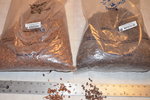As
@Stan Kengai said, particle shape is one difference.
In orchid horticulture bark is the mainstay substrate. Fir bark is usually bark from Douglas fir - Psuedotsuga. In orchid culture fir bark breaks down in as little as 2 years for orchids, but in orchids we want "fresh bark" , as a bonsai substrate we want composted bark. It takes fir bark about 6 months to become "composted" enough in a flower pot to achieve "composted status" and then the particles last about 4 years in bonsai culture. The bark will slowly break down into fine particles that will accumulate in the bottom of the pot. Mixes containing fir bark should be replaced before the 7 year mark. At about 5 to 6 years the bark will be mostly broken down.
North American domestic pine bark is exactly as Stan described it, and because of the flat shape it is not the best choice for as a significant % of a mix.
There is a product that is popular in the orchid community, Radiata Orchid Bark - it is Pine Bark from Pinus radiata - the Monterrey Pine. This bark is imported from New Zealand, from their extensive forestry projects. The bark is steam treated, the heat partially caramelizing the natural wood sugars in the bark, making the product much more stable. This bark will still be a recognizable particle 10 and 15 years in use in a bonsai mix. The particles are not as flat as domestic pine bark, much more similar to fir bark, even chunky. In orchid mixes it makes a very good long lasting substrate. I like it for a dry bonsai mix, such as one used for pines, it goes well as a component of an otherwise inorganic mix. It will retain the properties of the inorganic mix, as it does not hold near as much water as fir bark. Because it is imported, it is expensive, almost as expensive as Akadama in North America.
So
If you want to add water retention, and cellulose for mycorrhiza to eat, use fir bark. Will decompose, should repot before the 7 year mark, 5 year or less is ideal. Helps to create an acidic mix.
If you want a stable, particle that is very slow to decompose, but does eventually decompose choose the imported Radiata brand type pine bark. Good for up to 15 years in a mix. Does not add much water retention until the 4th year or later of use. Does eventually help acidify a mix. A long term stable particle.
Domestic North American pine bark - likely lodgepole, scots, American red pine, or southern yellow pine bark, what ever is being harvested locally - most of the time tends to be excessively flat particles makes it not useful. But if you do find a chunky, more block shape particle - it will work. Usually will not be heat treated, so stability is like that of douglas fir bark. It will help acidify the media, last about 5 to 7 years and provide "food" for mycorrhiza.
 www.bonsaijack.com
www.bonsaijack.com
 www.bonsaijack.com
www.bonsaijack.com



